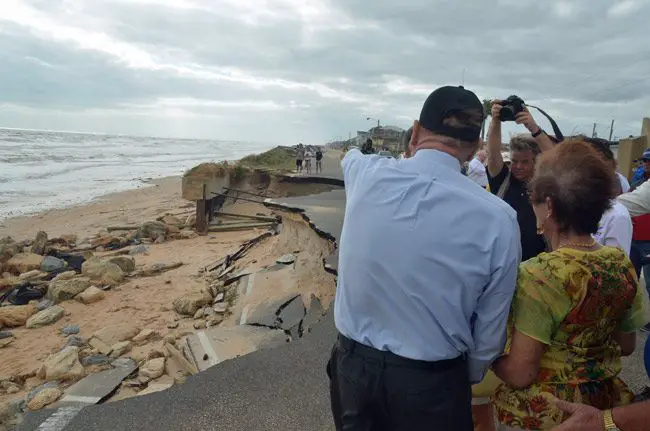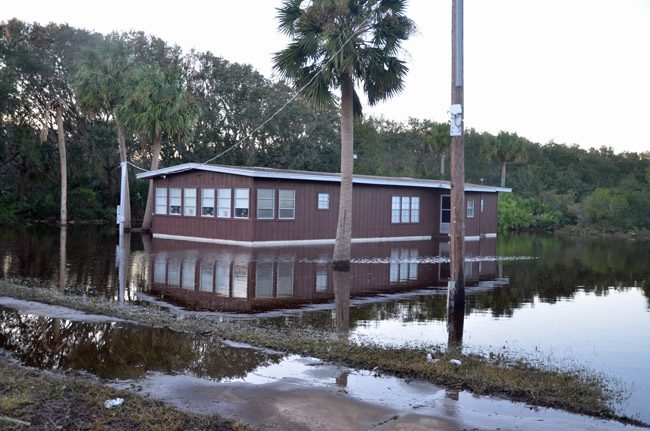
Florida ended its 2016 hurricane season Wednesday, marking the first time in more than a decade that the Sunshine State was hit by a hurricane–and the closest Flagler County came to a direct hit in decades.
When Hurricane Hermine came on shore near St. Marks, a coastal community south of Tallahassee, in the early morning hours of Sept. 2, it ended a record string of 3,966 days, or 10.87 years, without a hurricane making landfall in the state most prone to being hit by tropical storms, according to a new analysis by Colorado State University.
Prior to Hermine, a Category 1 storm, Florida was last hit by Hurricane Wilma, a 120-mph, Category 3 storm, which struck Southwest Florida on Oct. 24, 2005.
Florida also came close this year to a direct hit by a major hurricane, as Hurricane Matthew, which was the first Category 5 storm in the Atlantic basin since 2007, came within 50 miles of Florida’s East Coast, raking Flagler County and the state Oct. 6 and Oct. 7 before making landfall Oct. 8 in South Carolina as a 75 mph Category 1 hurricane.
But of the five named storms that made landfall in the United States in 2016–the most since 2008 when six storms struck–three struck Florida: Tropical Sorms Colin and Julia, and Hurricane Hermine. Tropical Storm Bonnie and Hurricane Matthew struck South Carolina.
Matthew’s near miss extended the United States’ streak of avoiding a landfall by a major hurricane, defined as a Category 3 storm with winds of 111 mph or higher, for 11 consecutive years, the longest streak based on records dating to 1851, according to Philip Klotzbach, the Colorado State University researcher who wrote the analysis. The last major landfall was with Wilma in 2005.
Still, for the Atlantic, this was the first above-normal season since 2012, according to the National Oceanic and Atmospheric Administration (NOAA). The Atlantic saw 15 named storms during 2016, including seven hurricanes (Alex, Earl, Gaston, Hermine, Matthew, Nicole, and Otto), three of which were major hurricanes (Gaston, Matthew and Nicole). NOAA’s updated hurricane season outlook in August called for 12 to 17 named storms, including five to eight hurricanes, with two to four of those predicted to become major hurricanes.
Although Matthew was a “close call” for Florida, the powerful storm caused extensive damage in coastal counties including Brevard, Volusia, St. Johns, Flagler and Duval. It knocked electrical power out for more than 1 million Florida homes and businesses. It produced more than 10 inches of rain resulting in extensive freshwater flooding over much of the eastern Carolinas. The storm was responsible for the greatest U.S. loss of life due to inland flooding from a tropical system since torrential rains from Hurricane Floyd caused widespread and historic flooding in eastern North Carolina in 1999.
In Flagler, it partly demolished a 1.3-mile stretch of State Road A1A at the south end of Flagler Beach, eroded dunes up and down the county’s entire coast, breached those dunes at Washington Oaks Gardens State Park and near Varn Park, flooded large swaths of the Hammock and left several homes along Painters Hill teetering on cliff-life sand walls, leaving them vulnerable to further tides. An emergency contract by the state Department of Transportation restored A1A to a driveable road within weeks.
It was only this week, on Monday, that Palm Coast completed its debris pick-up, which ended with the creation of three mountain-like piles of wood and debris on a stretch of land along U.S. 1. One of those piles inadvertently caught fire this week. The other two will be chipped and hauled off at a cost of $500,000.
On Friday, Florida Chief Financial Officer Jeff Atwater and Insurance Commissioner David Altmaier will discuss the 2016 Atlantic Hurricane Season and talk about local leaders’ insurance issues and needs at a round-table conversation at the Funky pelican, the restaurant attached to the Flagler Beach Pier, at 1:30 p.m.
Gov. Rick Scott, who faced his first hurricanes since taking office in 2011, said several lessons were learned from the storms. From Hermine, which plowed through Tallahassee and blacked out 80 percent of the electric power in the state capital, Scott said it underscored the need to better coordinate utility resources to restore power.
From Hurricane Matthew, which forced a number of counties to close schools for several days, Scott said the state “can work better at getting our schools opened faster.”
“The strength of Hurricane Matthew, as well as the increased number of U.S. landfalling storms this season, were linked to large areas of exceptionally weak vertical wind shear that resulted from a persistent ridge of high pressure in the middle and upper atmosphere over Caribbean Sea and the western Atlantic Ocean,” said Gerry Bell, lead seasonal hurricane forecaster at NOAA’s Climate Prediction Center. “These conditions, along with very warm Caribbean waters, helped fuel Matthew’s rapid strengthening.”
In terms of storm damage, the 2016 hurricane season fell far short of some of Florida’s worst seasons, including 1992’s Hurricane Andrew, which caused an estimated $24 billion in insured damages in Florida and Louisiana, according to the Insurance Information Institute.
With data reflected through October, the Florida Office of Insurance Regulation said Hermine resulted in $95 million in property-damage claims, with Leon County accounting for about 3,500 of the 18,222 claims.
Hurricane Matthew has resulted in more than 100,000 property-damage claims, representing $606 million in value. Volusia, Duval, Brevard, St. Johns and Flagler counties represented more than 70 percent of those claims.
Updated damage claim reports will be filed in December, according to state insurance regulators.
Citizens Property Insurance, the state-backed insurer, said it has paid out $10.7 million in claims related to Hermine and Matthew, with 84 percent of the 4,000 claims closed.
The impact was relatively light for the insurer, which has more than 472,000 policies representing $128 billion in exposure. But Barry Gilway, the Citizens president and CEO, said the 2016 storm season tested the insurer’s ability to handle hurricane claims.

In a new analysis of the national property-insurance industry, Fitch Ratings said damage from Matthew, which also impacted other states, including Georgia and South Carolina, is likely to fall at the “low end” of estimates in the range of $2 billion to $8 billion.
The six-month hurricane season was in line with an August estimate from Colorado State University, which had predicted 15 named storms in the Atlantic basin. There were 15 storms, although the three major hurricanes and seven overall hurricanes each exceeded the estimate by one storm each.
The season began with Hurricane Alex, a rare powerful January storm that remained far out in the Atlantic. The season ended with Hurricane Otto, the latest calendar year Atlantic hurricane on record to make landfall. It hit southern Nicaragua as a Category 2 storm last Thursday.
Several Atlantic storms made landfall outside of the United States during 2016: Tropical Storm Danielle in Mexico, Hurricane Earl in Belize, Hurricane Matthew in Haiti, Cuba, and the Bahamas, and Hurricane Otto in Nicaragua. The strongest and longest-lived storm of the season was Matthew, which reached maximum sustained surface winds of 160 miles per hour and lasted as a major hurricane for eight days from Sept. 30 to Oct. 7. Matthew was the first category 5 hurricane in the Atlantic basin since Felix in 2007.
As for the next few months, the Climate Prediction Center is indicating that precipitation in Flagler County is expected to remain well below normal through the next three months, Flagler County Emergency’s Bob Pickering, the weather specialist, reported this morning. This is due to ongoing La Nina conditions in the Pacific Ocean. Typical of a La Nina pattern is the below normal precipitation and above normal average temperatures for Florida.
“The U.S Drought Monitor indicates that drought conditions do not yet exist in Flagler County. However if current lack of precipitation continues then this will have to be monitored,” Pickering reported.
–FlaglerLive and the News Service of Florida





























Leave a Reply